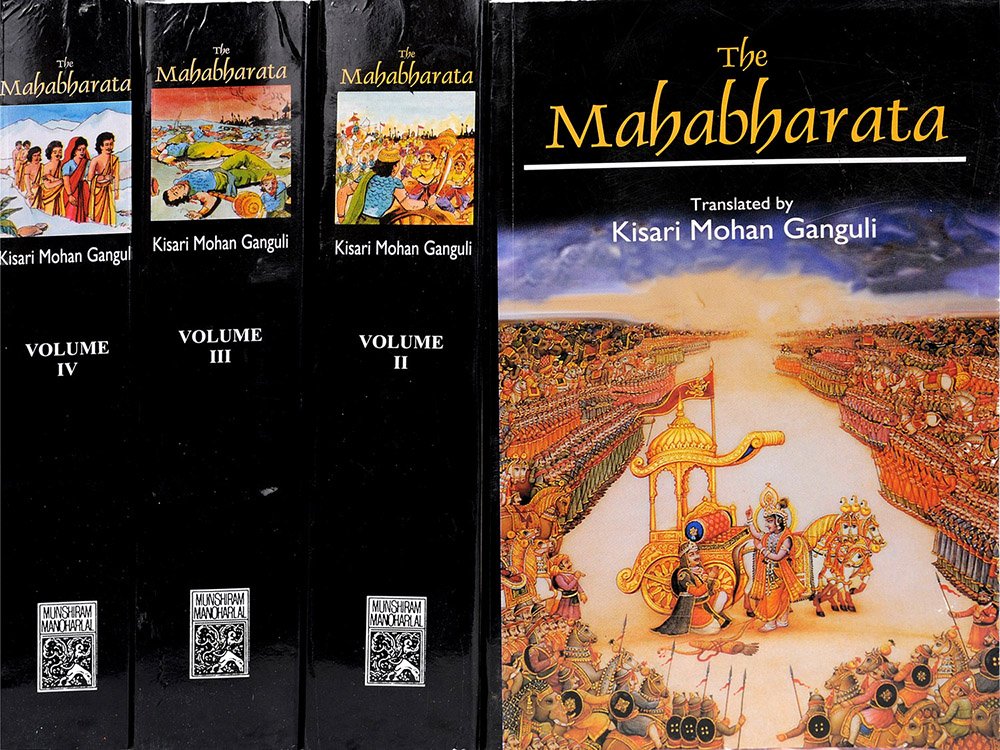Mahabharata (English)
by Kisari Mohan Ganguli | 2,566,952 words | ISBN-10: 8121505933
The English translation of the Mahabharata is a large text describing ancient India. It is authored by Krishna-Dwaipayana Vyasa and contains the records of ancient humans. Also, it documents the fate of the Kauravas and the Pandavas family. Another part of the large contents, deal with many philosophical dialogues such as the goals of life. Book...
Section CX
"Bhishma said,
'This our celebrated race, resplendent with every virtue and accomplishment, has all along sovereignty over all other monarchs on earth. Its glory maintained and itself perpetuated by many virtuous and illustrious monarchs of old, the illustrious Krishna (Dvaipayana) and Satyavati and myself have raised you (three) up, in order that it may not be extinct.
It behoves myself and you also to take such steps that this our dynasty may expand again as the sea. It has been heard by me that there are three maidens worthy of being allied to our race. One is the daughter of (Surasena of) the Yadava race; the other is the daughter of Suvala; and the third is the princess of Madra.
O son, all these maidens are of course of blue blood. Possessed of beauty and pure blood, they are eminently fit for an alliance with our family. O you foremost of intelligent men, I think we should choose them for the growth of our race. Tell me what you think.'
Thus addressed, Vidura replied,
'You are our father and you are our mother, too. You are our respected spiritual instructor.
Therefore, do you what may be best for us in your eyes.'
"Vaisampayana continued, ’soon after Bhishma heard from the Brahmanas that Gandhari, the amiable daughter of Suvala, having worshipped Hara (Siva) had obtained from the deity the boon that she should have a century of sons.
Bhishma, the grandfather of the Kurus, having heard this, sent messengers unto the king of Gandhara.
King Suvala at first hesitated on account of the blindness of the bridegroom, but taking into consideration the blood of the Kurus, their fame and behaviour, he gave his virtuous daughter unto Dhritarashtra and the chaste Gandhari hearing that Dhritarashtra was blind and that her parents had consented to marry her to him, from love and respect for her future husband, blindfolded her own eyes.
Sakuni, the son of Suvala, bringing unto the Kurus his sister endued with youth and beauty, formally gave her away unto Dhritarashtra. And Gandhari was received with great respect and the nuptials were celebrated with great pomp under Bhishma’s directions. And the heroic Sakuni, after having bestowed his sister along with many valuable robes, and having received Bhishma’s adorations, returned to his own city.
And, O you of Bharata’s race, the beautiful Gandhari gratified all the Kurus by her behaviour and respectful attentions. And Gandhari, ever devoted to her husband, gratified her superiors by her good conduct; and as she was chaste, she never referred even by words to men other than her husband or such superiors.'"
Conclusion:
This concludes Section CX of Book 1 (Adi Parva) of the Mahabharata, of which an English translation is presented on this page. This book is famous as one of the Itihasa, similair in content to the eighteen Puranas. Book 1 is one of the eighteen books comprising roughly 100,000 Sanskrit metrical verses.
FAQ (frequently asked questions):
Which keywords occur in Section CX of Book 1 of the Mahabharata?
The most relevant definitions are: Bhishma, Gandhari, Kurus, Dhritarashtra, Sakuni, Gandhara; since these occur the most in Book 1, Section CX. There are a total of 17 unique keywords found in this section mentioned 31 times.
What is the name of the Parva containing Section CX of Book 1?
Section CX is part of the Sambhava Parva which itself is a sub-section of Book 1 (Adi Parva). The Sambhava Parva contains a total of 78 sections while Book 1 contains a total of 19 such Parvas.
Can I buy a print edition of Section CX as contained in Book 1?
Yes! The print edition of the Mahabharata contains the English translation of Section CX of Book 1 and can be bought on the main page. The author is Kisari Mohan Ganguli and the latest edition (including Section CX) is from 2012.
